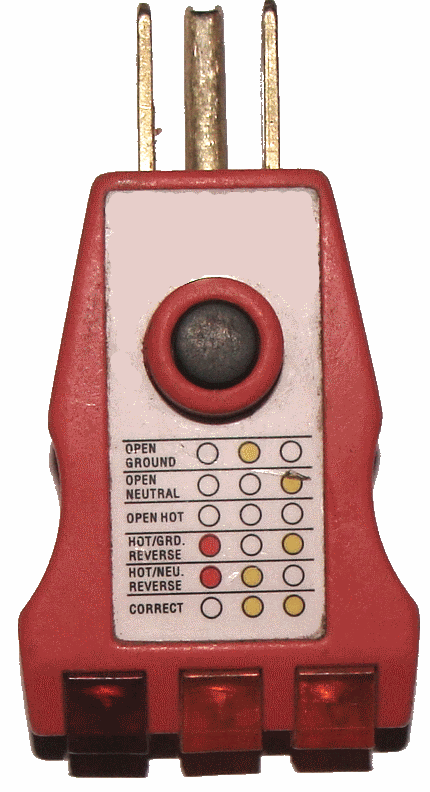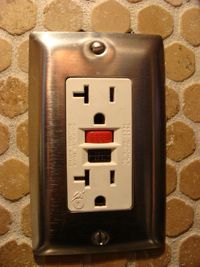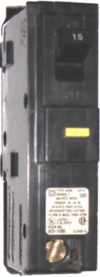Last week I gave an overview of what GFCI outlets are for. The long and short of it is that GFCIs are life safety devices; they prevent lethal shocks. This week I’ll talk about the different types of GFCI devices, how to test them, and what drives me crazy with them on home inspections.
The two most common types of GFCI devices are circuit breakers and outlets. A GFCI circuit breaker gets installed at the electric panel, and protects the entire circuit. This is a handy way to make sure everything on the circuit gets protected, and there is no need for individual GFCI outlets anywhere in the circuit. The other type, which everyone has already seen, is an outlet. The most common type of outlet is called a duplex receptacle, which is shown below left.
One GFCI outlet can protect several other non-GFCI outlets when wired properly. Every GFCI outlet has screws behind the outlet labeled “line” and “load”. The current coming into the outlet must always be connected to the “line” side of the outlet. If more outlets are going to be protected by the GFCI, they can be wired to the “load” side of the outlet. Many houses built during the 80’s will have the exterior outlets, garage outlets, and basement bathroom outlets wired downstream from a GFCI outlet in the upper level bathroom. Today it’s common for a GFCI outlet at the kitchen countertop to protect several other outlets.
A redundant way to wire GFCI outlets is to wire one GFCI downstream from a second GFCI outlet. This is wasteful, pointless, annoying, and it makes things difficult for the home inspector and anyone else that might trip the outlet using a GFCI tester, especially if the first GFCI outlet is hidden. And I don’t like it.
GFCI outlets should be tested every month because they can go bad, and a defective GFCI outlet doesn’t provide any life safety protection. To test a GFCI outlet or circuit breaker, simply press the test button. Here are the possible outcomes you can have by testing a GFCI outlet with the test button:
- Acceptable – The reset button pops and the power goes off. The GFCI device is functioning properly. Simply press the reset button to restore power.
- Unacceptable – The reset button doesn’t pop. This means the outlet is defective and should be replaced.
- Unacceptable – The reset button pops but the power doesn’t go off. This means the line and load are reversed at the outlet. This should be corrected. Newer GFCI outlets have a built-in safety feature that prevents the outlet from getting energized if it’s incorrectly wired or defective, but this was a common problem with older GFCI outlets.
- Unacceptable – The reset button is already popped, the power is off, and the reset button won’t go in. This can happen to newer GFCI outlets if they’re improperly wired or the outlet has gone bad.
 While the only ‘official’ way to test GFCI outlets is to use the built-in test button, GFCI outlet testers provide for a convenient way to verify that non-GFCI outlets are GFCI protected. Just plug it into an outlet and press the test button. If the power goes out, the outlet is wired downstream from a GFCI device. If the power stays on, it doesn’t mean the outlet is not wired downstream from a GFCI; it might be wired downstream from a defective GFCI outlet.
While the only ‘official’ way to test GFCI outlets is to use the built-in test button, GFCI outlet testers provide for a convenient way to verify that non-GFCI outlets are GFCI protected. Just plug it into an outlet and press the test button. If the power goes out, the outlet is wired downstream from a GFCI device. If the power stays on, it doesn’t mean the outlet is not wired downstream from a GFCI; it might be wired downstream from a defective GFCI outlet.
Why do GFCI outlets go bad? I honestly don’t know, and if anyone reading this blog can tell me, I’d be interested in hearing about it. From my own experience, I’ve found that after a GFCI outlet has had a lot of power running through it, it will often fail. For example, any time I’m working on a remodeling project and I’m running a bunch of power tools through a GFCI, it goes bad within about a month. I’ve heard of home builders wanting to put all of their GFCI outlets on the inside of the house because there’s this idea that cold Minnesota weather makes GFCI outlets go bad, but I haven’t experienced that myself, and a study on GFCI outlets has shown that temperature doesn’t have any effect.
Reuben Saltzman, Structure Tech Home Inspections – Email – Home Inspector in Minneapolis



